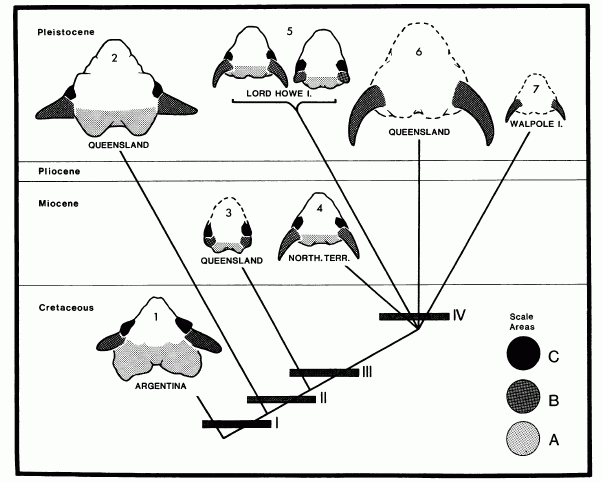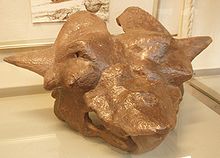
| Chelonii | ||
| The Vertebrates | Meiolaniidae |
| Vertebrates Home | Vertebrate | Vertebrate |
|
Abbreviated Dendrogram
Anapsida ?
│
└─○Chelonii
├─Odontochelys
└─┬─Proganochelys
└─┬─Proterochersis
└─○Cryptodira
├─Kayentachelys
└─┬─Condorchelys
├─Eileanchelys
└─┬─Solemydidae
├─○Meiolanoidea
│ ├─Chelycarapookus
│ ├─Chubutemys
│ ├─Naomichelys
│ └─┬─┬─Mongolochelys
│ │ └─Otwayemys
│ └─○Meiolaniidae
│ ├─Niolamia
│ └─┬─Ninjemys
│ └─Meiolania
└──┬─Kallokibotion
└─┬─Pleurodira
├─Paracryptodira
└─Eucryptodira
|
Contents
Overview |
Taxa on This Page

The Meiolaniidae were among the most extraordinary of all the chelonia. They were an exclusively Gondwanan family, known from South America, Australia, and nearby islands, and it can therefore be is assumed that they also lived in Antarctica in the Cretaceous and early Tertiary. They were large, probably herbivorous forms, with heavily armored heads and tails. The unusually shaped skull was characterised by many knob- and horn-like protrusions. The tail was protected by armored 'rings' and sported thorn-like spikes at the end. The club-like tail evolved independently of a similar structure in Proganochelys, and even the ankylosaurids and glyptodonts, the latter also distinguished by armoured rings around the tail. The animal survived on south pacific Islands until very recently where, like other endemic Island populations, it had few or no natural enemies and was was particularily vulnerable to human predation.
 |
| Dendrogram of meiolaniids, showing three scale areas (A, B, C) for comparison. (1) Niolamia argentina, (2) Ninjemys oweni, (3) Warkalania carinaminor, (4) Meiolania brevicollis, (5) Meiolania platyceps (showing two extremes of horn variation), (6) Meiolania sp., Wyandotte, (7) Meiolania mackayi. Gaffney 1996 p.120 |
Gaffney 1996 devoted much study to these creatures, and noted that on the one hand they had features similar to modern cryptodires, but on the other were much more primitive in many ways. He therefore classified them as stem centrocryptodires, intermediate between the Xinjiangchelyidae and the Sinemydidae, Others such as Joyce 2007, Anquetin, 2009, etc, who used a computational-statistical approach to cladistics rather than Gaffney's recognisable synapomorphy-based hennigian method, unanimously give it a much more basal stem position, in this case its many eucryptodire features would be examples of convergence. If this hypothesis is correct, the Meiolaniids were the chelonian equivalent of monotremes, living fossils, a relict group surviving alongside their more successful pleurodire and cryptodire (or marsupial and placental, to continue the analogy) contemporaies. If this hypothesis is correct it makes their recent extermination at the hands of man even more tragic. [1]
The Gondwanan Meiolaniids have also been grouped with Asiamerican forms in a larger clade. According to Anquetin, 2009, the North American species Naomichelys speciosa, traditionally classified in the family Solemydidae, another very primitive group, is closely related to the Meiolaniids as well as to Mongolochelys efremovi. This would make either the Solemydids as a whole related, or exclude Naomichelys from the Solemydids. According to Sterli (ref), the latest Cretaceous European Kallokibotion, traditionally considered the sister taxon to higher testadines (pleurodira + paracryptodira + eucrypotodira, or equivalent), may also be related, which gives the Meiolanoidea a cosmopolitan distribution, as well as making it one of the more important of the early testudine clades. MAK110922, 130130
Notes:
[1] This also raises a question about the stability of phylogenetic nomenclature. If crown taxa are defined by their existence in the modern world, and the last representatives of an imnportant sub-clade are wiped out in historical (or even recent) time, do all the previously crown taxa that had been included suddenly become stem taxa? Is an arbitrary historical cut off point decided? And if it is, what are the defining factors. And for that matter, if a long-extinct animal, say a woolly mammoth, had to becloned and brought back to lifde (something conceivably possible within the next few decades given current advances in genetic engineering), would a previous stem group then become a crown clade?
Range: Cretaceous to Holocene, probably cosmopolitan during the Late Cretaceous.
: : Chubutemys + (Naomichelys + ?Solemydidae) + (Otwayemys + Mongolochelys) + Meiolanoidea
Comments: the greatest surprise of recent cladistic analyses is the emergence of an important and previously unrecognised clade of stem testudines, of which the Meiolaniids are only the most specialised, and only Cenozoic, forms (Hirayama, Brinkman, & Danilov, 2000, Anquetin 2009, Sterli, 2010, Pérez-García & Murelaga (2012). The group seems to have originated in Western Gondwana sometime between the Middle Jurassic and the Early Cretaceous and if Kallokibotion is included it had a cosmopolitan distribution duyring the late Cretaceous (Sterli, 2012). The term Meiolanoidea is not usually used in the literature, but was suggested by Gaffney. An equally appropriate and complementary name is Ceratocryptodira (Bour & Dubois 1986).
Range: Middle Cretaceous of Patagonia
Comments:
Range: Early Cretaceous
Comments: .
Range: Late Cretaceous of N Am
Comments:
Range: Early Cretaceous Eumeralla Formation, Victoria, Australia
Casichelydia ::: (Meiolaniidae + Mongolochelys) + *
Comments: The shell of Otwayemys is similar to Xinjiangchelys from the Jurassic of China; although it might be a member of the Centrocryptodira, possibly closely related to the Sinemydidae of Asia on the basis of the opisthocoelous cervicals Gaffney et al 1998. Both anterior and posterior caudals of this turtle, however, are opisthocoelous as in Meiolania, Mongolochelys, and baenids, and along with other factors (Hirayama et al 2000 p.189). A lot depends also on whether Meiolaniids are centrocryptodires or stem turtles; If the latter it would mean that formed central articulation on the cervical and caudal vertebrae (and therefore greater flexibility of the neck and tail, and the loss of mesoplastron (retained only in primitive forms) were acquired independently of the centrocryptodires.
References: Gaffney et al 1998
 |
| Carapace of Mongolochelys (Mongolochelyidae) from the Nemegt Formation, Late Cretaceous of Gurilin Tsav, Western Gobi.(from Suzuki & Narmandakh 2004) |
Mongolochelys: Mongolochelys efremovi,
Range: (Late Cretaceous (Maastrichtian) of Mongolia
Casichelydia ::: (Meiolaniidae + * ) + (Kallokibotion + (Pleurodira + Cryptodira)) (Joyce 2007)
Comments: Large turtles, probably aquatic. Contain a unique combination of primitive and advanced features, the only Central Asian chelonian apart from the much earlier Chengyuchelys, to retain mesoplastra, a very primitive feature. Perhaps on this this basis, both these forms are generally considered stem Testudines. However there are no indications that these two general are otherwise related. In other features, variously resembles the early Jurassic Kayentachelys, the latest Cretacous (contemporary) Kallokibotion, and most of all the late Jurassic and Early Cretaceous Pleurosternidae (Sukhanov, 2003, p.349) whilst some unite it with the Meiolaniidae (Hirayama, Brinkman, & Danilov, 2000, Joyce 2007,Joyce 2007, Anquetin 2009, p.196, etc).
Links: Albanerpeton and Mongolochelys (life reconstruction), A catalog of Mongolochelys collected by the HMNS-MPC Joint Paleontological Expedition (PDF)
 Meiolaniidae Lydekker 1889 : huge, "horned" turtles.
Meiolaniidae Lydekker 1889 : huge, "horned" turtles.
Range: Eocene (or possibly Cretaceous) of Argentina, Miocene to the Pleistocene of Australia, Pleistocene to Holocene of nearby islands.
Parent clades: Either Centrocryptodira : (Sinemydidae + Polycryptodira) + *
or Casichelydia ::: Otwayemys + (Mongolochelys + * ) (Hirayama, et al, 2000, Anquetin 2009, p.196)
Daughter clades: * : Niolamia (Ninjemys + Meiolania)
Characters: "horned" head; tail spiked, with club. The nasomaxillary sinuses are unique to meiolaniids, but their presence/absence can only be determined in Ninjemys and Meiolania. Their function is not known (Gaffney 1996 p.119; Anquetin 2009, p.196).
Comments: An isolated group that although similar to extant cryptodires cannot be matched with any specific groups (Carroll 1988 p.212). Studies by Gaffney put them in the Centrocryptodira Gaffney, 1996. More recent cladistic studies (Joyce 2007, Anquetin 2009) place them outside the Testudine crown group. These animals reached upto 2.5 meters in length (unlike recent chelonians, the tail is very long), with the horned skulls upto 30 to 50 cm wide. Like modern giant tortoises, which they resemble in size and perhaps lifestyle, they were most likely herbivores.
Links: Wikipedia
References: Shaffer et al. (1997). ATW020214.
Illustration: Meiolania platyceps, photograph by Claire Houck, Wikipedia/creative commons
Synonym: Crossochelys
Range: Cretaceous or Eocene of Argentina
Meiolaniidae : (Ninjemys + Meiolania) + *
Comments:. The earliest known and least specialsed member of the family, known only from the skull and tail ring,
References: Gaffney 1996
Meiolania: M. platyceps, M. brevicollis, M. mackayi and "Wyandotte species". However only platyceps and brevicollis can be diagnosed adequately (Gaffney 1996 p.92)-
Synonyms: Miolania, Ceratochelys
Range: Oligocene to Late Pleistocene of Australia, Pleistocene to Holocene of Lord Howe Island, New Caledonia, Vanuata, etc
Meiolaniidae : Niolamia (Ninjemys + *)
Characters: snout broad, horns point to the rear
Comments:. The type genus and best known member of the family, common in the Pleistocene of Australia and nearby Lord Howe Island. Mainland forms has a shell length of about a meter, and an overall length of 2.5 meters. This makes it the second-largest known tortoise, surpassed only by the Pleistocene Colossochelys atlas of Asia. Specimens from New Caledonia and Lord Howe Island however were rather smaller, as a result of island dwarfism. Relic populations survived until only 2000 years ago, but were wiped out after only two hundred years (link), although it is even possible some may have survived until the 18th century (Gaffney et al 1984). The Pleistocene fossils from Lord Howe Island are particularly well-known.
Links: Meiolania the Horned Turtle; Meiolaniidae; Meiolania; PANGEA; qui (French); Fassaden German); Wikipedia, photo - Australian Museum
References: Gaffney 1996
 |
| Skull of Ninjemys oweni. Wikipedia - photo by Ghedo |
Ninjemys: Ninjemys oweni
Range: Late Pleistocene of Queensland, Australia
Meiolaniidae : Niolamia (Meiolania + *)
Characters: laterally projecting (side-pointing) B horns (the largest pair of horns ); anterior extension of the nasals beyond rest of skull (Gaffney 1996 p.78); snout narrow (a primitive feature)
Comments: a large meiolaniid, immediately distinguished from Meiolania by the side-pointing horns. Known only from skull and tail. The generic name honours the Teenage Mutant Ninja Turtles. Its weight is estimated at 200 kg.
Links: Wikipedia
References: Gaffney 1996
checked ATW030416, page MAK100917. Page last modified MAK110922. All material by ATW is public domain and may be freely used in any way (also any material jointly written by ATW and MAK). All material by MAK is licensed Creative Commons Attribution License Version 3.0, and may be freely used provided acknowedgement is given. All Wikipedia material is either Gnu Open Source or Creative Commons (see original Wikipedia page for details). Other graphics are copyright their respective owners